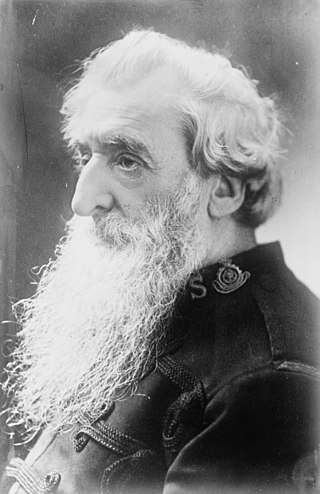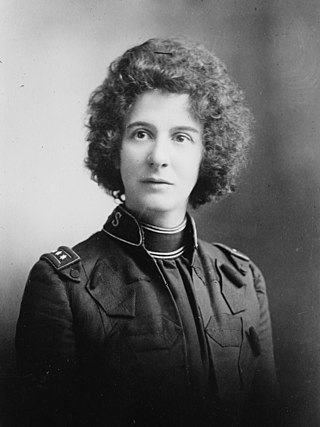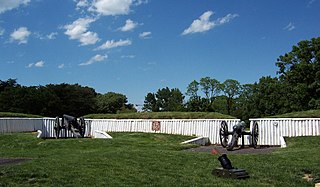Related Research Articles

The Salvation Army (TSA) is a Protestant Christian church and an international charitable organization headquartered in London, England. It is aligned with the Wesleyan-Holiness movement. The organization reports a worldwide membership of over 1.7 million, consisting of soldiers, officers, and adherents who are collectively known as salvationists. Its founders sought to bring salvation to the poor, destitute, and hungry by meeting both their "physical and spiritual needs.". It is present in 133 countries, running charity shops, operating shelters for the homeless, and disaster relief and humanitarian aid to developing countries.

The Grand Army of the Republic (GAR) was a fraternal organization composed of veterans of the Union Army, Union Navy, and the Marines who served in the American Civil War. It was founded in 1866 in Decatur, Illinois, and grew to include hundreds of "posts" across the North and West. It was dissolved in 1956 at the death of its last member, Albert Woolson.

William Booth was an English Methodist preacher who, along with his wife, Catherine, founded the Salvation Army and became its first General (1878–1912). The Christian movement with a quasi-military structure and government founded in 1865 has spread from London to many parts of the world. It is known for being one of the largest distributors of humanitarian aid.

John Alfred Larsson was a Swedish Salvationist, writer and composer of Christian music and hymns, who was the 17th General of The Salvation Army.

Evangeline Cory Booth, OF was a British evangelist and the 4th General of The Salvation Army from 1934 to 1939. She was the first woman to hold the post.

Promoted to Glory is a term used by The Salvation Army to describe the death of a born again Christian.
The Salvation Army U.S.A. Western Territory is an administrative unit of The Salvation Army that serves the thirteen Western United States, the Marshall Islands, the Federated States of Micronesia and Guam. The territory is one of four Salvation Army Territories within the United States of America. The Western Territorial Headquarters is located in Rancho Palos Verdes, California, and is currently under the leadership of Commissioner Douglas Riley. The territory is divided geographically into nine divisions, each headed by a divisional commander.

Shaw Clifton was an Salvation Army Officer born to Salvation Army officer parents stationed in Northern Ireland, who served as the 18th General of the Salvation Army. He succeeded John Larsson on 2 April 2006.

Clarence Dexter Wiseman, was the tenth General of The Salvation Army from 1974 to 1977.

Fort Ward is a former Union Army installation now located in the city of Alexandria in the U.S. state of Virginia. It was the fifth largest fort built to defend Washington, D.C. in the American Civil War. It is currently well-preserved with 90-95% of its earthen walls intact.

Fort Reynolds was a Union Army redoubt built as part of the defenses of Washington, D.C., in the American Civil War.

Fort Corcoran was a wood-and-earthwork fortification constructed by the Union Army in northern Virginia as part of the defenses of Washington, D.C. during the American Civil War. Built in 1861, shortly after the occupation of Arlington, Virginia by Union forces, it protected the southern end of the Aqueduct Bridge and overlooked the Potomac River and Theodore Roosevelt Island, known as Mason's Island.

George Morton Randall was a major general in the United States Army, noted for his service in the American Civil War and Indian Wars. He was born in Conneaut, Ohio, the son of Brewster Randall (1807–1880) and Harriet Eliza Fifield Randall (1819–1878).

George Scott Railton was a Scottish-born Christian missioner who was the first Commissioner of The Salvation Army.

Commissioner Frederick St. George de Lautour Booth-Tucker, was a senior Salvation Army officer of the late nineteenth and early twentieth centuries, and the son-in-law of Willam and Catherine Booth, the Army's founders.
The American Rescue Workers is a Christian denomination and charity in the United States. The organization was founded in 1882 by Thomas E. Moore as a splinter group from The Salvation Army in response to financial disagreements between Moore and Salvation Army founder William Booth. In 1885 the organization officially adopted a charter as the Salvation Army of America, but in 1913 it was renamed American Rescue Workers and has functioned under this name since that time. Its quasi-military organization suggests that the charity retains similarities to the Salvation Army as with the Volunteers of America. The charity operates shelters for the homeless, workshops for the disabled, and halfway houses for the chemically dependent in addition to engaging in evangelism. American Rescue Workers publishes a quarterly periodical, The Rescue Herald.

An officer in The Salvation Army is a Salvationist who is an ordained minister of the Christian faith, but who fulfills many other roles not usually filled by clergy of other denominations. They do so having been trained, ordained and commissioned to serve and lead and given a title which uses the terms of typical military rank.

Commissioner John Lawley was a Commissioner in The Salvation Army, the second highest rank attainable by Officers in the organisation, and the highest 'appointed' rank. An early Salvationist, he joined The Salvation Army in 1877 when it was still called The Christian Mission. He was aide-de-camp to General William Booth from 1890 to 1912 as well as to General Bramwell Booth from 1912 to 1921.

The 93rd New York Infantry Regiment was an infantry regiment in the Union Army during the American Civil War.

Fort Farnsworth is a former Union Army installation now located in the Huntington area of Fairfax County, Virginia. It was a timber and earthwork fortification constructed south of Alexandria, Virginia as part of the defenses of Washington, D.C. during the American Civil War. Nothing survives of the fort's structure as the Huntington Station of the Washington Metro occupies Fort Farnsworth's former hilltop site.
References
- ↑ Swain, Jason (2021). "Chapter Three: Beloved By Flawed". Under Two Flags The Rise, Rebellion, And Rebuilding Of The Salvation Army In America 1870-1913. Alexandria, Virginia: Crest Books. p. 27.
- ↑ Swain, Jason (2021). "Chapter Three: Beloved By Flawed". Under Two Flags The Rise, Rebellion, And Rebuilding Of The Salvation Army In America 1870-1913. Alexandria, Virginia: Crest Books. pp. 27–28.
- 1 2 3 4 Farrow, Mike (2011-07-08). "Lost Tribe? The Thomas Moore Secession and Beyond". Archived from the original on 2023-01-07. Retrieved 2023-07-15.
- 1 2 McKinley, Edward (1980). "Chapter I. 1880-1890". Marching To Glory The History of The Salvation Army in the United States. New York, New York: Harper & Row. p. 25.
- 1 2 Swain, Jason (2021). "Chapter Three: Beloved By Flawed". Under Two Flags The Rise, Rebellion, And Rebuilding Of The Salvation Army In America 1870-1913. Alexandria, Virginia: Crest Books. p. 28.
- ↑ The Salvation Army Central Territory. "Salvation Army History". Archived from the original on 2022-06-26. Retrieved 2023-07-15.
- ↑ McKinley, Edward (1980). "Chapter I. 1880-1890". Marching To Glory The History of The Salvation Army in the United States. New York, New York: Harper & Row. pp. 25–26.
- ↑ Swain, Jason (2021). "Chapter Three: Beloved By Flawed". Under Two Flags The Rise, Rebellion, And Rebuilding Of The Salvation Army In America 1870-1913. Alexandria, Virginia: Crest Books. p. 33.
- ↑ McKinley, Edward (1980). "Chapter I. 1880-1890". Marching To Glory The History of The Salvation Army in the United States. New York, New York: Harper & Row. pp. 26–28.
- ↑ McKinley, Edward (1980). "Chapter I. 1880-1890". Marching To Glory The History of The Salvation Army in the United States. New York, New York: Harper & Row. pp. 28–30.
- ↑ "Christianity in Action: The International History of the Salvation Army" . Retrieved 2023-07-15.